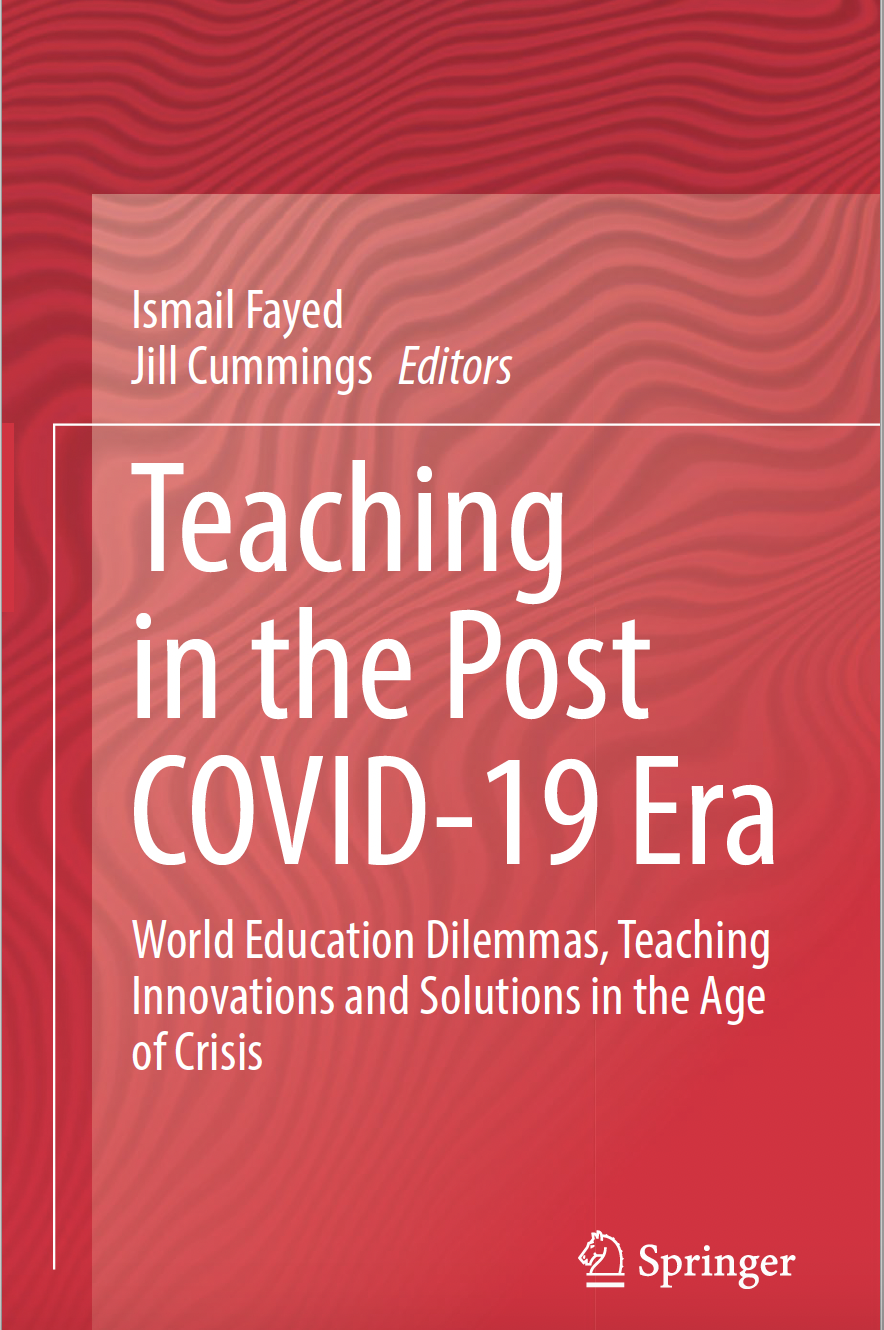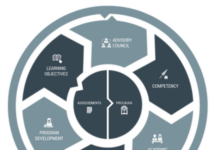
Fayed, I. and Cummings, J. (2021) Teaching in the Post Covid 19 Era Springer: Cham, Switzerland, 764 pp
This is a longish post – you may want to jump to my review at the end.
What is the Book About?
The book is sub-titled World Education Dilemmas, Teaching Innovations and Solutions in the Age of Crisis.
The book:
- describes practical educational technology solutions implemented during the COVID-19 situation and implications for future adaptation,
- details program-specific designs and curriculum innovations in online teaching/learning that address the needs of International post-secondary students, immigrants and refugees and
- addresses sustainability of education during the 21st century crisis events and the future of education
It should be clear though that this book is solely about higher and post-secondary education. It does not cover k-12 (school) experiences (other than teacher training).
Who are the contributors?
The co-editors are Ismail Fayed and Jill Cummings. Ismail Fayed is Project Director, Educational Technology, and Jill Cummings is Associate Dean of Faculty Development, at Yorkville University, a private university headquartered in New Brunswick, Canada.
There are 141 contributors, of whom 85 (60%) are from Canada, 19 (13%) from the USA, 13 from the Middle East, 8 from Europe/UK, 7 from Latin America, 6 from South and East Asia, and 4 from Australia/New Zealand. Thus although North American authors predominate (73%), there is a good smattering of contributors from other regions of the world.
What is in the book?
The book is 764 pages long and the 73 chapters are organised into five sections:
Part 1: Teaching in Crisis Situations
This contains 22 chapters, ranging from:
- evaluating student engagement in Zoom classes,
- how an academic innovation center was able to encourage its students to engage in creative problem-solving through design thinking, emerging technologies, and experiential learning during the COVID-19 pandemic
- teaching agency in an indigenous community in Northern Canada during Covid-19 from a critical pedagogy perspective
- the experience of a Canadian community college that accelerated its plans for digital and flexible learning during Covid-19
- perceptions of teaching and learning of parents, students and teachers in Egypt during Covid-19
- the importance of entertainers during Covid-19
- the impact of the digital divide on adult literacy programs during Covid-19
- a two year program created at OISE, University of Toronto, to develop of a set of principles and strategies to support faculty in online or blended graduate-level learning environments
- the results from a university-wide survey of students at a 4-year public university in southern California. The survey was administered at the on-start of the campus shifting from face-to-face instruction to a virtual learning environment.
There are another eleven chapters in this section, all reflecting the variety of experiences – and also the lack of coherence – that will be found throughout the book
Part 2 Alternative Course Delivery Modes
This contains 10 chapters, including an innovative way to teach film directing remotely at Toronto Film School (a chapter I was particularly interested in because my grandson in the UK dropped out of a film directing course because it was taught so badly during Covid-19).
However, I could not understand what the difference in grouping of this section was compared to the first – it was also a rag-bag of different experiences at individual institutions, nearly all focused on variations of Zoom-based teaching.
Part 3 Innovative Teaching and Assessment Paradigms in Crisis Situations
This is another 22 chapters mainly of ‘what I did during Covid-19’, but with some chapters focusing on assessment and its limitations during Covid-19.
What stood out for me was the one chapter in the book that looked at pre-Covid best practices in online learning as a way of connecting with students (Sher and Toor: ‘Achieving Success in Online Teaching and Learning: Strategies’.) It was though thoroughly disheartening to read another chapter on the quality of teaching during Covid-19 without reference to any of the work on quality assurance of online and distance learning that preceded Covid-19.
There was also a number of chapters with helpful strategies for improving student engagement, including one on the use of gamification.
Part 4 Teacher Education and Leadership in Crisis Situations
These 11 chapters are a bit more focused on the experience of institutional administrators and institutional strategies during Covid-19, including faculty development efforts and teacher training.
Part 5 Supporting mental health in times of anxiety
These eight chapters are very important, and the most focused part of the book.
Supplementary materials
The related website at http://www.2020era.ca hosts teaching and learning activities, videos, podcasts, and other exemplary digital resources to expand the practical use of this Handbook.
If you wish to participate in the book launch on March 2, details are available here: https://yorkvilleu-tfs.zoom.us/meeting/register/tJEqdu6trDgqHNR_DBG752bt7_08QKtNq2c5%20/
My review
A major contribution to understanding how post-secondary education responded during the pandemic
The editors have done a very good job at finding a huge number and a wide variety of cases of how instructors, students and institutions responded to the challenge of Covid-19. This will certainly be a valuable historical document tracking the way post-secondary instructors, students and institutions around the world responded to the challenge of moving all teaching off-campus within a couple of weeks.
Once again, I am astounded at the initiatives and efforts of everyone in post-secondary education during Covid-19, students, instructors and administrators alike. There are many examples here of innovative teaching, particularly using synchronous technology such as Zoom in other ways than just lecturing, of the effect on mental health of moving everything to synchronous online teaching in particular for students and instructors, and of attempts to accommodate or improve assessment when it was moved online.
However, this was a very difficult book to read for several reasons.
Length
Obviously there must be a market for these Handbooks on… otherwise Springer wouldn’t keep publishing them. But no-one is going to read this 764 page book from end to end. Readers are going to dip in and out. There is an index at the end but it is pretty limited – for instance different countries are not indexed.
Organisation
To justify a book this long, it needs a good deal of organisation and facilitation from the editors which unfortunately is lacking.
Each part needs an introduction (or conclusion) that pulls out the main themes or lessons learned within that part. Without this the whole book ends up as an endless list of ‘what we did during Covid-19.’
I could find little coherence or clear differences in the first three parts of the book. If there was a theme holding together articles in one part and differentiating them from articles in the other two parts, I couldn’t see it. The last two parts on assessment and mental health were much more coherent.
However, the book desperately needs a concluding chapter which pulls together the main strands in the book and suggests ways forward, either post-pandemic or for the next crisis.
What did we learn from Covid-19?
It might make a good Ph.D. thesis for a student to try to pull out consistent themes or overall lessons learned about teaching in a pandemic from the evidence in this book, but I left little wiser about how the system as a whole could do better next time in an emergency or even what major lessons were learned for the future, or how extensive or limited these lessons are, other than the most obvious (more faculty development, better access to the internet, relevant mental health supports). But how to teach better in the next crisis or in the future as a result of Covid-19? Forget it. There were nuggets in this book but no mother load.
Lack of historical context
Reading this book, a visitor from Mars would think that online learning was invented in March, 2020. Very, very few of the articles made any reference to all the 30 years of research, evidence and experience of online learning that existed before Covid-19. Is this relevant in a crisis? Maybe not. Does this mean that in the next emergency everyone will go back to Zoom lectures? Was there no institution or instructor that did something different from synchronous or streamed lectures? Will there be a return to asynchronous learning post-pandemic? Apparently not. Reading this book one would think that lecture-based teaching rules in post-secondary education, even or especially in a crisis. I am sure this is the truth, but if it is, it’s very sad.
Still a useful contribution to our understanding of emergency teaching
We may wish things are different from what they are, but we still need to address reality. This book does this. It reflects the realities of post-secondary teaching during the pandemic. There are important lessons for the future in the book if you are willing to dig for them.
Instructors and students made a huge effort to keep teaching and learning during the pandemic. What I left with though from this book was how much work still needs to be done to make teaching more effective, not just online but in general. There is all that knowledge about what works and what doesn’t when teaching online. Some was re-discovered during Covid-19, but in general it was ignored.
However, the real problem here is not online learning, but what are increasingly outdated and ineffective lecture methods, which become even more ineffective when transferred online without modification. That surely is one of the most important lessons from the pandemic.









 Dr. Tony Bates is the author of eleven books in the field of online learning and distance education. He has provided consulting services specializing in training in the planning and management of online learning and distance education, working with over 40 organizations in 25 countries. Tony is a Research Associate with Contact North | Contact Nord, Ontario’s Distance Education & Training Network.
Dr. Tony Bates is the author of eleven books in the field of online learning and distance education. He has provided consulting services specializing in training in the planning and management of online learning and distance education, working with over 40 organizations in 25 countries. Tony is a Research Associate with Contact North | Contact Nord, Ontario’s Distance Education & Training Network.

